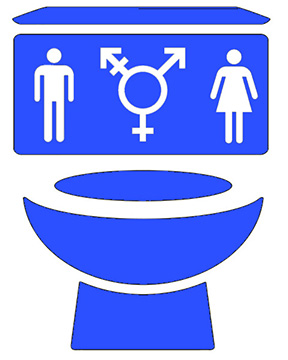Inclusive bathrooms would be right for Cardinal community

Lamar seems to pride itself on inclusivity, but all too often I feel excluded as a nonbinary individual on campus. I have a basic human necessity that I must do daily — use the bathroom.
However, unlike a majority of individuals on campus, using the bathroom is never a simple task for me or other transgender students on campus. Using the bathroom is a daily internal battle because the bathroom I use does not match my identity.
When using the women’s bathroom I feel uncomfortable and invalidated in my nonbinary identity. I feel as though everyone sees me as a woman and I am not. Using the men’s bathroom has never even been a consideration for me because I fear that I would not be safe.
Every time I use the bathroom I must choose between mental discomfort or the fear for my safety. I should not have to make that decision.
I am not alone in this problem. According to a survey conducted by the Williams Institute in 2016, an estimated 0.6 percent of the U.S. adult population identify as transgender. Lamar currently has an undergraduate enrollment of 8,904 students which means an estimate of 54 undergraduate students identify as transgender.
To some, 54 students may not seem like a lot of people. I, however, recognize this number as 54 other individuals who likely have to make the same uncomfortable decision about using the bathroom on a daily basis. If every transgender undergraduate student on campus were to be in one class together, they could occupy almost every seat in the largest class that I have taken at Lamar. This just shows that 54 students is a large number of people who are not being represented on campus.
I am aware that most of the buildings on campus were built before gender inclusive bathrooms were utilized in the United States, but even the newer buildings are lacking in their bathroom inclusivity. The only gender inclusive bathroom on campus, located in the Setzer Student Center, is not even referred to as a gender inclusive bathroom — it is referred to as a family bathroom. One bathroom is not true inclusivity.
The easiest and cheapest way to incorporate gender inclusive bathrooms on campus is to change the signage on any single-stall bathrooms. When considering converting multi-stall bathrooms, colleges must consider both complying to Texas building codes and student privacy.
Chapter 29 of the Building Code of the Texas Industrialized Housing and Buildings Program dictates the number of men’s and women’s plumbing fixtures a given building needs in relation to the building’s size, but gender-inclusive spaces are not considered in the codes. As a result, converting a men’s or women’s restroom into a gender-inclusive one may take a building out of compliance.
If converting a multi-stall bathroom into a gender inclusive bathroom does not take a building out of compliance with Texas building codes, it should be an option that Lamar should take into consideration. All multi-stall bathrooms can be converted into gender-inclusive bathrooms via a signage change, but for student safety and privacy, all bathrooms and urinals should have a floor-to-ceiling stall.
Gender-inclusivity is not only possible, it is a necessity. Going to the bathroom is a mentally exhausting task for me and it is about time for that to change. Lamar needs gender inclusive bathrooms on campus.
I deserve inclusivity.
